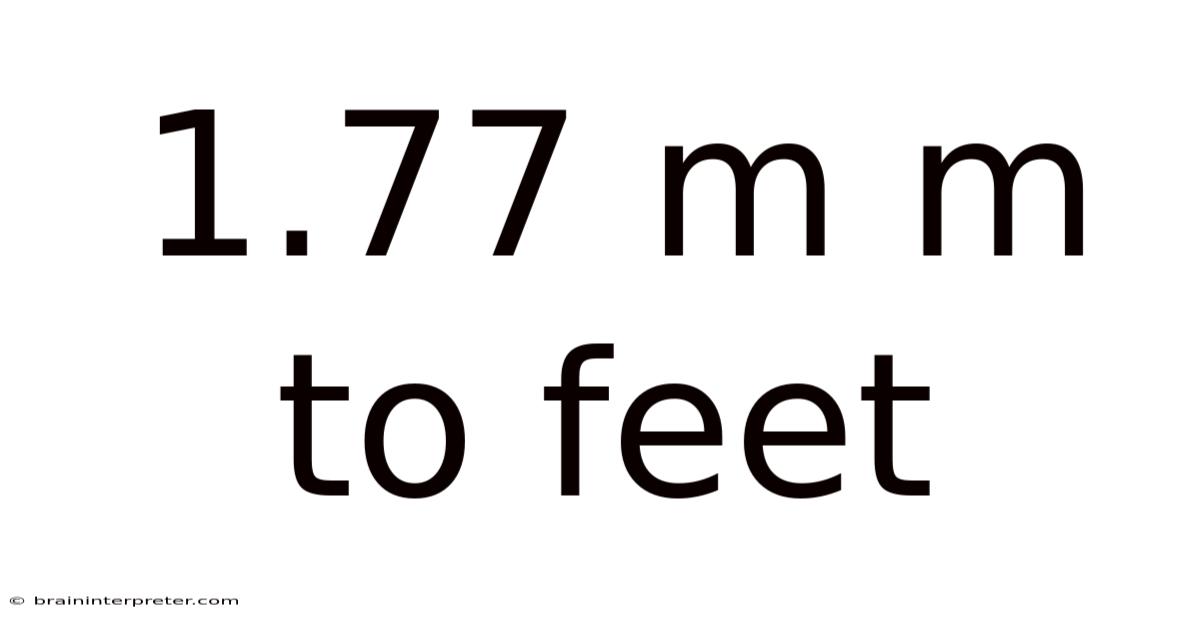1.77 M M To Feet
braininterpreter
Sep 17, 2025 · 4 min read

Table of Contents
Converting 1.77 Millimeters to Feet: A Comprehensive Guide
Understanding unit conversions is crucial in many fields, from engineering and construction to everyday life. This article provides a comprehensive guide on how to convert 1.77 millimeters (mm) to feet (ft), explaining the process step-by-step, exploring the underlying mathematical principles, and addressing frequently asked questions. We'll delve into the intricacies of the conversion, ensuring you not only get the answer but also understand the methodology behind it. This detailed explanation will help you confidently perform similar conversions in the future.
Understanding the Units: Millimeters and Feet
Before diving into the conversion, let's define the units involved. Millimeters (mm) are a unit of length in the metric system, representing one-thousandth of a meter (1 mm = 0.001 m). Feet (ft), on the other hand, are a unit of length in the imperial system, with one foot being approximately 12 inches. The discrepancy between these systems requires a conversion factor to accurately translate measurements from one to the other.
Step-by-Step Conversion: 1.77 mm to Feet
The conversion from millimeters to feet requires two main steps:
-
Converting Millimeters to Meters: As mentioned, 1 millimeter is equal to 0.001 meters. Therefore, to convert 1.77 mm to meters, we multiply:
1.77 mm * 0.001 m/mm = 0.00177 m
-
Converting Meters to Feet: Now we need to convert meters to feet. The conversion factor is approximately 3.28084 feet per meter. Therefore:
0.00177 m * 3.28084 ft/m ≈ 0.005806 ft
Therefore, 1.77 millimeters is approximately 0.005806 feet.
Mathematical Explanation: The Conversion Factors
The conversion relies on established conversion factors. These factors are ratios that express the equivalence between different units. In our case:
- Millimeters to Meters: 1 mm = 0.001 m (This is a definition within the metric system)
- Meters to Feet: 1 m ≈ 3.28084 ft (This is an approximation, as the exact conversion involves an irrational number)
These factors are used as multipliers to translate measurements between different units. Multiplying by the conversion factor ensures that we maintain the same physical quantity while changing the unit of measurement. The use of approximately (≈) in the meters-to-feet conversion highlights the inherent imprecision in some unit conversions between metric and imperial systems.
Precision and Significant Figures
It's important to consider the precision of our measurements and the resulting calculations. The initial measurement of 1.77 mm suggests a precision to two decimal places. However, the conversion factor introduces additional decimal places. The final answer of 0.005806 ft might appear to be more precise than justified. In practice, we would likely round the final answer to a level of precision consistent with the original measurement. Depending on the context, rounding to 0.006 ft might be appropriate, reflecting the inherent limitations in the original measurement's precision.
Practical Applications of Millimeter to Foot Conversions
Conversions between millimeters and feet are common in various fields:
-
Engineering and Manufacturing: Designing and producing components often requires converting between metric and imperial units to ensure compatibility with different standards and equipment.
-
Construction and Architecture: Blueprints and construction plans might use both metric and imperial units, necessitating precise conversions.
-
3D Printing and Modeling: Many 3D modeling software packages utilize either metric or imperial units, requiring conversion for accurate scaling and dimensioning.
-
Everyday Applications: While less frequent than in specialized fields, situations like measuring furniture or comparing international product dimensions might necessitate these conversions.
Addressing Common Questions (FAQ)
Q1: Why is the conversion factor for meters to feet not an exact number?
A1: The conversion factor between meters and feet is based on the definition of the meter and the foot. Historically, these units had different origins and definitions. The current conversion factor is an approximation that arises from these historical differences and the inherent complexities of relating these two systems.
Q2: Can I use online calculators for this conversion?
A2: Yes, many online calculators are available to quickly convert millimeters to feet. However, understanding the underlying principles is crucial for appreciating the limitations and potential inaccuracies inherent in any conversion process.
Q3: What if I need to convert a larger number of millimeters?
A3: The same principles apply. Simply multiply the number of millimeters by 0.001 to get meters and then by 3.28084 to get feet. For larger numbers, consider using a calculator or spreadsheet software to streamline the calculations.
Q4: Is there a formula I can use for this conversion?
A4: Yes, the formula can be expressed as:
Feet = Millimeters * 0.001 m/mm * 3.28084 ft/m
This concise formula allows for direct calculation, avoiding the need for multiple steps.
Conclusion: Mastering Millimeter to Foot Conversions
Converting 1.77 millimeters to feet, or any other millimeter-to-feet conversion, involves a straightforward process utilizing established conversion factors. This guide emphasizes not only the mechanics of the conversion but also the underlying mathematical principles and the importance of considering precision and significant figures. By understanding these aspects, you'll be equipped to perform these conversions confidently and accurately in any context requiring the translation between metric and imperial units of length. Remember, the ability to perform unit conversions is a fundamental skill applicable across numerous disciplines. Practicing these conversions will solidify your understanding and enhance your problem-solving abilities in related fields.
Latest Posts
Latest Posts
-
1 4 Pound To Oz
Sep 17, 2025
-
400 Sq Feet In Meters
Sep 17, 2025
-
1983 How Old Am I
Sep 17, 2025
-
How Many Iu To Mg
Sep 17, 2025
-
Half A Tablespoon To Teaspoon
Sep 17, 2025
Related Post
Thank you for visiting our website which covers about 1.77 M M To Feet . We hope the information provided has been useful to you. Feel free to contact us if you have any questions or need further assistance. See you next time and don't miss to bookmark.